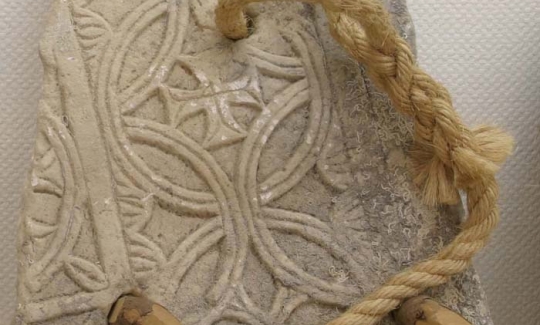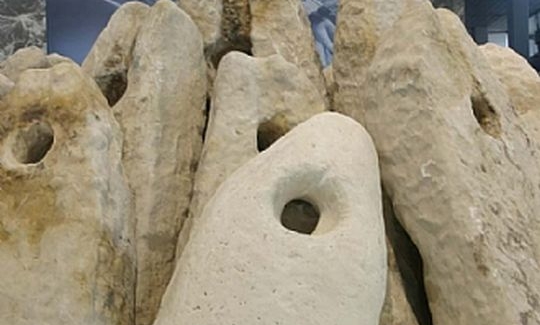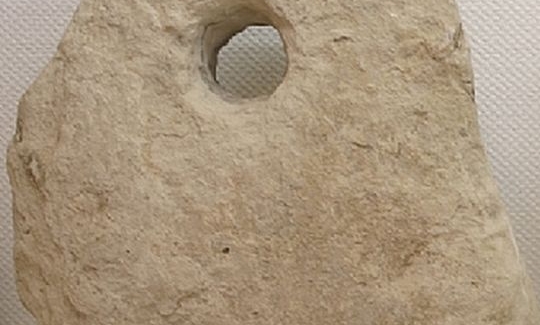One of the concerns of seafarers of all times has been how to halt their vessel in mid-ocean when necessary. The first sailors solved the problem by lowering a rock tied to a rope onto the sea-bed. In a calm sea, the rock would hold the ship in place simply by its weight. With time, the sailors learned to adjust the size and weight of the rock to their vessel. As ships increased in size, so the anchors became heavier. Larger ships made sure of safe anchoring by using several anchors. Even smaller craft did not depend on a single anchor, and always had an emergency supply on board.
The earliest anchors, of the Middle Bronze period, were stone plates, sometimes worked, with a hole carved out at one end for the insertion of a rope. Since stone loses about one third of its weight in the water, large, heavy anchors were needed. The average weight of such an anchor varied between 80-200 kg., but some have been found to weigh as much as 500 kg., in spite of which every vessel that put to sea carried a large number of them. They were lowered from the prow and the stern.
Even in ancient times, seafarers realized that they could not rely merely on the weight of the stone anchor, and that they could reinforce it by increasing its ability to fasten itself to the sea-bed. In the end of the Late Bronze Age (12th century BCE) a new type was developed, characterized by three holes - one in the upper part, and two in the lower part. Through the two lower holes they inserted wooden pegs which grounded themselves in the sand and reinforced the anchor's hold. Initially these stone anchors were large and heavy, but as the 3-hole anchors became more prevalent and their advantages were realized, the size was reduced, as was the number carried by each vessel.
As of the 7th - 6th centuries BCE, they began to develop anchors composed of a central shank with one or two arms. Later, in order that the anchor should always have at least one arm embedded in the ocean floor, they added to the upper section, a broad post - the anchor stock. The first wooden anchors were made with a fixed stone stock. Later they made hollow wooden stocks and filled them with lead, and even later they were made solely of lead. The ultimate prototype of the wooden anchor had removable shanks made of lead (2nd century BCE - 3rd century CE). This development was practical for storage, since reserve anchors could be taken apart and stowed more efficiently in the space available on board.
The Romans' control of the mines and their knowledge of iron production were conducive to the fact that in the 2nd and 3rd centuries CE they began to make anchors of forged iron, similar in shape to the wooden anchors. The main features of the iron anchor were its strength, its weight, and its uniformity of size, making it the preference of all seafarers, and this was also true during the Byzantine era, though with slight modifications in design.
In the Middle Ages, a new type of iron anchor appeared, known as the "cat anchor". This anchor was made of forged iron and had a central shank from which extended 4-7 arms ending in claws. These extensions ensured that, however the anchor fell, at least one arm would engage with the sea-bed.
Obviously, however, such improvements would be costly, so that the owners of smaller sailing craft, who had only limited means, continued to use the stone anchors which were always available. Hence the two types - the stone anchor and the improved metal anchor - have been found, from all periods and all waterways.
The shape of the anchor and its make often establish the level of culture of its maker. It must be remembered that stone anchors can be used for hundreds of years, handed down from generation to generation. So that only when an anchor is present in an archaeological finding, together with such articles as pottery, coins, etc. or at an archaeological site on land, or illustrated on coins, mosaics or elsewhere, can the period when the anchor was last in use be established.
An anchor retrieved from the sea does not necessarily denote the site of a wreck. Some anchors may have been dropped but, for some reason, were not raised. Some, for example, may have embedded themselves so deeply that they had to be cut loose from the ship before it could sail on. Sometimes there was no time to raise the anchor before fleeing sudden storms or the approach of an enemy vessel.
The shape of the anchor has been modified by means of new technologies, but it derives from a utility that has not changed over thousands of years. Improvements have resulted from attempts to use suitable materials.



